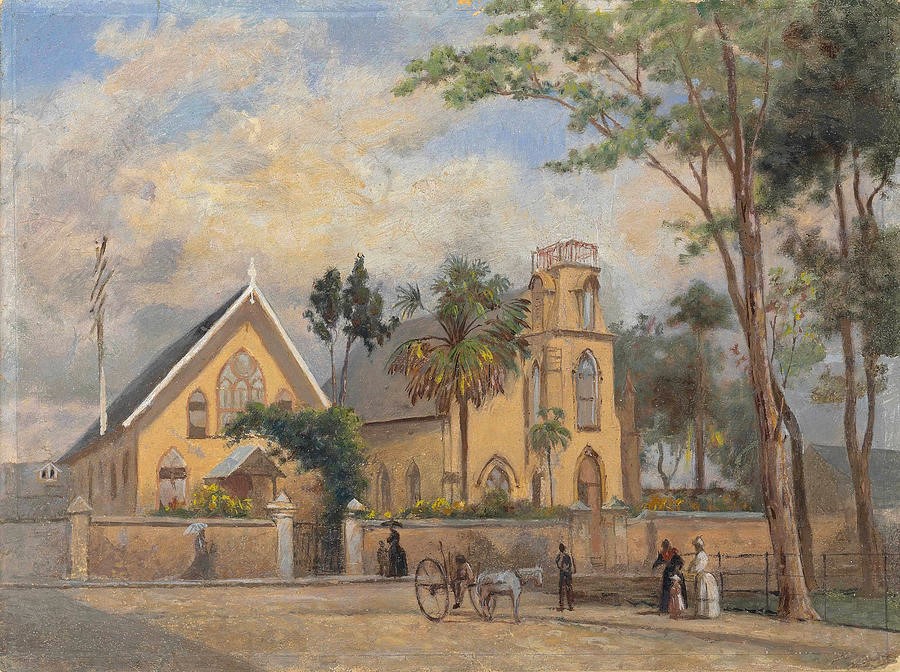On April 15th we are celebrating World Art Day! This global event was started by UNESCO to help reinforce the links between artistic creations and society, encourage greater awareness of the diversity of artistic expressions and highlight the contribution of artists to sustainable development (Unesco.org). On World Art Day, the National Trust would like to share the impact of Art history and why we as a nation should value the contributions of our local Trinbagonian artists to our heritage.
Did you know the National Trust of Trinidad and Tobago can list and protect works of Art?
An artwork deemed to possess an established provenance, which is the documented history of its existence, ownership and use, context in society at large or in the more personal world of a known individual, allows us at the National Trust to prove the authenticity and quality of an artwork and guide us in the listing and protection of the artwork. It is important to note, that artworks created by our local artists hold immense value and are worthy of being protected. By listing these artworks this also encourages the conversation of art history and why it is important.
What is Art History?
Art History is the study of history and evolution of various forms of visual arts such as painting, photography, sculpture and other art mediums. Its importance lies in its ability to gather information on different societies and periods in history through the way in which they represented themselves visually. Through the study of art history key clues can be unearthed about long-gone civilizations and how they lived, worked, and functioned. Recent investigations into the origins of certain art pieces even helped us define art movements and the ways in which art effect or support changes in the society e.g. Black Lives Matter Movement.
In Trinidad and Tobago we hold a rich art historical tradition. Although not much has remained from the pre-Columbian era, many items that have been found, especially in Tobago point to the fact that the objects that were created by our indigenous ancestors served many functions e.g household, religious etc. as well as an artistic or aesthetic function. Thus, many objects that have been unearthed are considered to be part of the early art history of the islands. During the 1800s one of Trinidad’s earliest fine artists, Michel-Jean Cazabon (1813-1888) dominated the colonial era with this art. There is no other record of a locally born artist producing work at that time. The magic of his work lies in the photographic record of what the landscape of Trinidad looked like in the 1800s before there were digital cameras to capture it all. Thankfully, a collection of his work can be viewed at the National Museum and through the Office of the Prime Minister’s Legacy Exhibition. (https://www.opm.gov.tt/cazabons-legacy-exhibition/)

Image of a painting by Michel-Jean Cazabon of Greyfriars Church, Frederick Street, Port of Spain, Trinidad. Source: fineartamerica.com
After Cazabon’s death there was a lull in art creation until the 1930s when the Society of Trinidad Independents was formed by local artists led by Amy Leong Pang. This group was the precursor to the Trinidad Art Society (now the Trinidad and Tobago Art Society) which was founded in 1943. Over the years many different art groups and organizations have been formed catering to the needs of all types of artists from across the island. For example, the Women in Arts Organization is led by, and made up of women artists only and catering to the needs of women artists. Trinidad and Tobago artists have produced all types of art from sculpture to paintings to even carnival costumes (mas) being considered a special kind of art, unique to our culture which has its own very important traditions and history.
Artists such as Michel-Jean Cazabon, Amy Leong Pang, Sybil Atteck, Hugh Stollmeyer, Carlisle Chang, Willie Chen, Boscoe Holder, Leroy Clarke, Jackie Hinkson, Ralph and Vera Baney, M.P. Alladin, Isaiah Boodhoo, Shastri Maharaj, Peter Minshall, Christopher Cozier, Che Lovelace, Glen Roopchand, Wendy Nanan, Kwynn Johnson all from different time periods are some of the key artists which have contributed significantly to our art history.
Carlisle Chang’s “Conquerabia is an artwork which was listed (meaning legally protected) by the National Trust of Trinidad and Tobago as a Grade D Property of Interest. Find out more about the listing process and protection of our tangible heritage HERE. Conquerabia is a mural primarily cast in cement with other added materials located outside the Port of Spain City Hall on the ground floor. Conquerabia is believed to be the original name of the Amerindian settlement that preceded the Spanish city, but in many ways the mural sums up Chang’s vision of the entire country. It epitomises, too, his vision of its art, in its symbolism, its style and even the materials used in its construction. Artworks in Trinidad can be found at the Royal Victoria Institute (National Museum), the Central Bank Museum, Angostura Limited Collection, Bermudez collection, major banks, private galleries and major art collectors such as Christine Millar. There are many historic works of art that are worthy of protection under the National Trust Act. You can get involved and nominate them by using the nomination form on our website HERE

Photograph of Conquerabia by Carlisle Chang. Source : Joshua Leu Chee Kong.
We at the National Trust of Trinidad and Tobago wish to encourage the celebration of our local art and artists as we value the contributions made to our culture and art history through their unique and remarkable artistic expressions.
Author: Maya Doyle
Editor: Kara Roopsingh
Sources
Nimah Muwakil-Zakuri, Curator, Central Bank Museum
National Trust of Trinidad and Tobago

